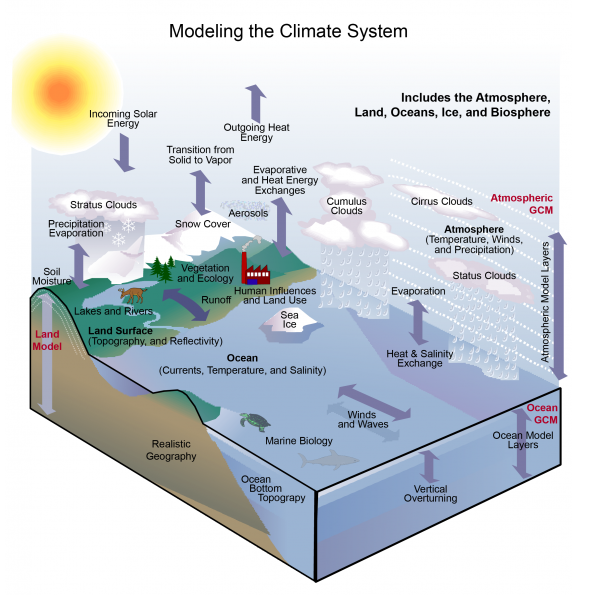Climate change models are complex computer-based tools used by scientists to simulate and understand the Earth’s climate system and make projections about future climate conditions. These models are essential for studying the potential impacts of climate change and for informing policy decisions. Watch a TedX video on Climate Modeling Here. Here’s an overview of how climate change models work:
Basic Components of Climate Models:
- Atmosphere: Climate models simulate the behavior of the Earth’s atmosphere by dividing it into a three-dimensional grid. Various equations are used to describe the physical processes governing atmospheric behavior, including fluid dynamics, thermodynamics, and radiative transfer.
- Ocean: Models also include representations of the ocean, which is another crucial component of the Earth’s climate system. Ocean models simulate the movement of water masses, heat, and other properties in the world’s oceans.
- Land Surface: The land surface, including vegetation and soil, is an integral part of climate models. These models include representations of land processes, such as evaporation, transpiration, and heat exchange with the atmosphere.
- Sea Ice: Climate models account for the presence and behavior of sea ice in polar regions. They simulate processes like ice formation, melting, and movement.
- Coupling: Climate models couple these various components together, allowing them to interact with each other. For example, changes in the atmosphere can influence ocean currents, and vice versa.
Numerical Methods:
- Climate models rely on numerical methods to solve the complex equations governing the physical processes. These methods involve breaking down time and space into discrete steps and grid cells, which are then solved iteratively to simulate the behavior of the climate system over time.
Input Data:
- Climate models require extensive input data, including historical observations of temperature, precipitation, greenhouse gas concentrations, and other climate-related variables. These data help initialize the model and validate its performance.
Forcing Scenarios:
- To project future climate change, models use different scenarios of future greenhouse gas emissions and other relevant factors, known as “forcing scenarios.” These scenarios include different assumptions about future human activities, such as population growth, energy use, and technological advancements.
Validation and Calibration:
- Climate models are tested against historical climate data to ensure they can accurately reproduce past climate variability and trends. Model calibration is an ongoing process to improve their performance.
Simulation and Projections:
- Once validated, climate models are used to simulate future climate conditions under various scenarios. These projections provide insights into how the Earth’s climate may change in response to different levels of greenhouse gas emissions and other factors.
Uncertainty and Sensitivity Analysis:
- Climate models incorporate uncertainty analysis to account for the inherent uncertainty in modeling the climate system. Scientists conduct sensitivity analyses to understand how different parameters and processes affect model results.
Peer Review and Improvement:
- Climate models and their results undergo rigorous peer review within the scientific community. Feedback from experts helps improve the models and increase confidence in their projections.
It’s important to note that climate models are continually refined and updated as our understanding of the climate system and our ability to collect data improve. They are valuable tools for assessing the potential consequences of climate change and informing climate policy decisions.
To learn more on the basics of climate modeling, read this USDA article here.

Jeff is founder of Terra Vida Academy and has been actively involved in protecting nature for over 35 years.




